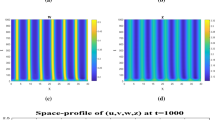Abstract
This paper is concerned with the steady state problem of a chemotaxis model with singular sensitivity function in a one dimensional spatial domain. Using the chemotactic coefficient \(\chi \) as the bifurcation parameter, we perform local and global bifurcation analysis for the model. It is shown that positive monotone steady states exist as long as \(\chi \) is larger than the first bifurcation value \(\bar{\chi }_1.\) We further obtain asymptotic profiles of these steady states, as \(\chi \) becomes large. In particular, our results show that the cell density function forms a spike, which models the important physical phenomenon of cell aggregation.
Similar content being viewed by others
References
Alikakos, N.D.: \(L^p\) bounds of solutions of reaction–diffusion equations. Commun. Part. Differ. Equ. 4, 827–868 (1979)
Bellomo, N., Bellouquid, A., Tao, Y., Winkler, M.: Toward a mathematical theory of Keller–Segel models of pattern formation in biological tissues. Math. Models Methods Appl. Sci. 25, 1663–1763 (2015)
Chen, X., Hao, J., Wang, X., Wu, Y., Zhang, Y.: Stability of spiky solution of Keller–Segel’s minimal chemotaxis model. J. Differ. Equ. 257, 3102–3134 (2014)
Chertock, A., Kurganov, A., Wang, X., Wu, Y.: On a chemotaxis model with saturated chemotactic flux. Kinet. Relat. Models 5, 51–95 (2012)
Childress, S., Perkus, J.: Nonlinear aspects of chemotaxis. Math. Biosci. 56, 217–237 (1981)
Crandall, M.G., Rabinowitz, P.H.: Bifurcation from simple eigenvalues. J. Funct. Anal. 8, 321–340 (1971)
Eisenbach, M.: Chemotaxis. Imperial College Press, London (2004)
Fitzpatrick, P.M., Pejsachowicz, J.: Parity and generalized multiplicity. Trans. Am. Math. Soc. 326, 281–305 (1991)
Fujie, K.: Boundedness in a fully parabolic chemotaxis system with singular sensitivity. J. Math. Anal. Appl. 424, 675–684 (2015)
Fujie, K., Senba, T.: Global existence and boundedness of radial solutions to a two dimensional fully parabolic chemotaxis system with general sensitivity. Nonlinearity 29, 2417–2450 (2016)
Fujie, K., Tomomi, Y.: Boundedness in a fully parabolic chemotaxis system with strongly singular sensitivity. Appl. Math. Lett. 38, 140–143 (2014)
Gui, C., Wei, J.: Multiple interior peak solutions for some singularly perturbed Neumann problems. J. Differ. Equ. 158, 1–27 (1999)
Gui, C., Wei, J.: On multiple mixed interior and boundary peak solutions for some singularly perturbed Neumann problems. Can. J. Math. 52, 522–538 (2000)
Gui, C., Wei, J., Matthias, W.: Multiple boundary peak solutions for some singularly perturbed Neumann problems. Ann. Inst. H. Poincaré Anal. Non Linéaire 17, 47–82 (2000)
Hillen, T., Painter, K.: A user’s guide to PDE models for chemotaxis. J. Math. Biol. 58, 183–217 (2009)
Horstmann, D.: From 1970 until present: the Keller–Segel model in chemotaxis. Jahresber DMV 105, 103–165 (2003)
Horstmann, D.: From 1970 until present: the Keller–Segel model in chemotaxis. Jahresber DMV 106, 51–69 (2004)
Keller, E., Segel, L.: Initiation of slime mold aggregation viewed as an instability. J. Theor. Biol. 26, 399–415 (1970)
Keller, E., Segel, L.: Model for chemotaxis. J. Theor. Biol. 30, 225–234 (1971)
Lin, C.-S., Ni, W.-M., Takagi, I.: Large amplitude stationary solutions to a chemotaxis system. J. Differ. Equ. 72, 1–27 (1988)
Liu, P., Shi, J., Wang, Z.: Pattern formation of the attraction–repulsion Keller–Segel system. Discrete Contin. Dyn. Syst. Ser. B 18, 2597–2625 (2013)
Nagai, T., Senba, T., Yoshida, K.: Global existence of solutions to the parabolic systems of chemotaxis. RIMS Hokyuroku 1997, 22–28 (1009)
Nanjundiah, V.: Chemotaxis, signal relaying and aggregation morphology. J. Theor. Biol. 42, 63–105 (1973)
Ni, W.-M.: Diffusion, cross-diffusion, and their spike-layer steady states. Not. Am. Math. Soc. 45, 9–18 (1998)
Ni, W.-M., Takagi, I.: Locating the peaks of least-energy solutions to a semilinear Neumann problem. Duke Math. J. 70, 247–281 (1993)
Osaki, K., Yagi, A.: Finite dimensional attractor for one-dimensional Keller–Segel equations. Funkcial. Ekvac. 44, 441–469 (2001)
Patlak, C.: Random walk with persistence and external bias. Bull. Math. Biophys. 15, 311–338 (1953)
Pejsachowicz, J., Rabier, P.J.: Degree theory for \(C^1\) Fredholm mappings of index \(0\). J. Anal. Math. 76, 289–319 (1998)
Shi, J., Wang, X.: On global bifurcation for quasilinear elliptic systems on bounded domains. J. Differ. Equ. 246, 2788–2812 (2009)
Stinner, C., Winkler, M.: Global weak solutions in a chemotaxis system with large singular sensitivity. Nonlinear Anal. Real World Appl. 12, 3727–3740 (2011)
Wang, Q.: On the steady state of a shadow system to the SKT competition model. Discrete Contin. Dyn. Syst. Ser. B 19, 2941–2961 (2014)
Wang, X.: Qualitative behavior of solutions of chemotactic diffusion systems: effects of motility and chemotaxis and dynamics. SIAM J. Math. Anal. 31, 535–560 (2000)
Wang, X., Xu, Q.: Spiky and transition layer steady states of chemotaxis systems via global bifurcation theory and Helly’s compactness theorem. J. Math. Biol. 66, 1241–1266 (2013)
Wang, Z.: Mathematics of traveling waves in chemotaxis—review paper. Discrete Contin. Dyn. Syst. Ser. B 18, 601–641 (2013)
Wei, J.: Existence and Stability of Spikes for the Gierer–Meinhardt System. Handbook of Differential Equations: Stationary Partial Differential Equations, vol. 5, pp. 487–585. Elsevier, Amsterdam (2008)
Winkler, M.: Global solutions in a fully parabolic chemotaxis system with singular sensitivity. Math. Methods Appl. Sci. 34, 176–190 (2011)
Xiang, T.: A study on the positive nonconstant steady states of nonlocal chemotaxis systems. Discrete Contin. Dyn. Syst. Ser. B 18, 2457–2485 (2013)
Author information
Authors and Affiliations
Corresponding author
Additional information
This project is partially supported by China Postdoctoral Science Foundation (No. 2016M590335) and National Natural Science Foundation of China (Nos. 11701180 and 11671144).
Rights and permissions
About this article
Cite this article
Li, H. Spiky Steady States of a Chemotaxis System with Singular Sensitivity. J Dyn Diff Equat 30, 1775–1795 (2018). https://doi.org/10.1007/s10884-017-9621-3
Received:
Published:
Issue Date:
DOI: https://doi.org/10.1007/s10884-017-9621-3



